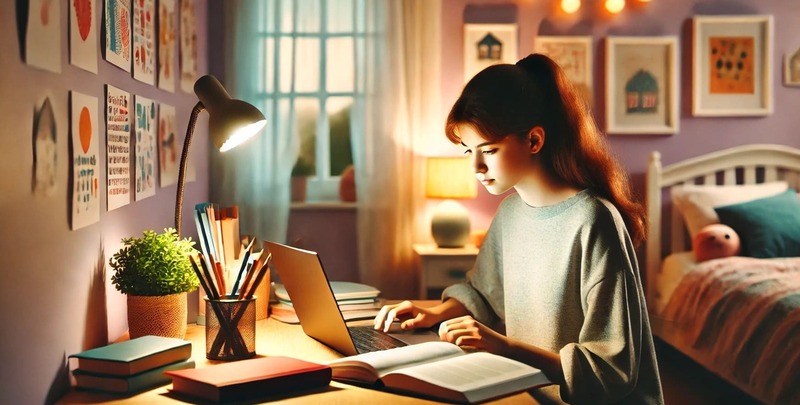What Is the Best Light for Studying?
Choosing the right lighting for studying is more important than many people realize. The quality of light in your study area can greatly affect your focus, reduce eye strain, and improve overall productivity.
Whether you're studying during the day or working late into the night, the right kind of lighting can make a big difference in how well you concentrate.
In this guide, we’ll look at the best lighting options for a home study space. We'll cover natural vs. artificial light, color temperature, and other features that can help you create the perfect environment for learning. Finding the right light can transform your study experience and help you reach your academic goals more efficiently.
Natural Light vs. Artificial Light
Natural light is often the best choice for studying. Exposure to daylight can boost your mood, increase energy, and improve concentration. If your study area has access to sunlight, try to position your desk near a window to take full advantage of it.
However, relying only on natural light isn’t always possible. During the evening or in rooms with limited sunlight, artificial lighting becomes essential. It provides consistent illumination so you can study comfortably at any time of day.
When choosing artificial lights, go for options that mimic natural daylight as closely as possible. LED lights are a great choice—they offer bright, clear light without flickering, which helps reduce eye strain and keeps you focused for longer periods.

Types of Artificial Lighting for Studying
Selecting the right type of artificial lighting can make a big difference in your study environment. Here are some popular options:
- LED Lights: Energy-efficient and long-lasting, they provide bright, steady light without flickering—ideal for long study sessions.
- Fluorescent Lights: Common in offices and classrooms, they offer even coverage but may flicker slightly, which some find distracting.
- Halogen Lights: These give off a bright, white light similar to daylight but can get hot, making them less ideal for small spaces.
- Smart Bulbs: Offer adjustable brightness and color temperature via an app or voice control, allowing you to customize your lighting for different tasks.
Each type has its pros and cons, so choose based on your needs and study habits.
Color Temperature and Its Impact
Understanding color temperature—measured in Kelvin (K)—is key to creating a productive study space.
- Warm Light (2700K–3000K): Soft, yellowish glow. Great for relaxation but not ideal for focused work.
- Neutral Light (3500K–4100K): Balanced, cool-white tone. Best for most study environments due to clarity and reduced eye strain.
- Cool Light (5000K–6500K): Bright, blue-toned light like daylight. Helps keep you alert, but too harsh for late-night study sessions.
Choose the right color temperature based on the time of day and your study goals to stay focused and comfortable.
The Importance of Adjustable Lighting
Adjustable lighting gives you control over brightness and direction, helping you tailor the environment to your needs. Dimmable lights are especially useful, letting you adjust the light level depending on the task and time of day.
A desk lamp with an adjustable arm or neck allows you to direct light exactly where you need it—whether reading, writing, or working on a screen. This targeted lighting reduces shadows and glare, making your workspace more efficient and comfortable.
Investing in adjustable lighting means you can create a flexible study space that adapts to your needs, improving both comfort and productivity.

Additional Features to Consider
When looking for the best light for studying, don’t just focus on brightness and color temperature. Other features can make a big difference:
- Adjustable brightness: Allows you to customize light levels for different tasks and times of day.
- Flexible design: Lamps with rotating heads or adjustable arms help direct light precisely where needed.
- Glare control: Built-in shades or diffusers reduce glare from screens and glossy surfaces.
- Smart controls: Voice or app-based adjustments add convenience and flexibility.
- Energy efficiency: LEDs save power and last longer, making them a cost-effective choice.
These features can enhance your study experience, making your space more comfortable and effective for deep focus.
Improve Your Focus and Productivity
Choosing the right lighting for studying is crucial for creating a productive and comfortable learning environment. Whether you prefer natural light or rely on artificial options, understanding how color temperature and adjustable lighting affect your focus can help you study better.
By adding features like anti-glare and smart controls, you can further optimize your space. The right lighting setup can significantly improve your ability to concentrate and achieve your academic goals more effectively.
Please note: This information is for general advice only. Regulations vary by location, so consult local authorities or a professional before making changes. See our Terms & Conditions for more details.
Metal Storage Containers For Food
Nowadays, people's lives can basically meet the requirements of food and clothing, and they are still improving. With the improvement of living standards, people have begun to have a higher pursuit for the quality of life. When purchasing various health care products, it is only reassuring to choose the ones with higher packaging levels. Even the common grains and cereals are more popular if they are properly packaged in iron boxes.
In the past few years, many Chinese people like to pursue foreign imported products, and feel that the quality of domestic enterprises' goods is not at ease. In fact, another reason is that the domestic packaging level is not high in the early days. The gunny bag and cloth bag packaging are more sophisticated than imported products, and it is difficult to enter the high-end consumer market in terms of sales. The use of Iron Box packaging can largely ensure the quality of damaged boxes during transportation. Iron box packaging materials, patterns and colors can be better matched, and the packaging is far more exquisite than other types of packaging, thus increasing the competitiveness of products.
How to design iron box packaging for cereals?
For example, for iron box packaging of cereals and cereals, more traditional ethnic cultures, including Chinese calligraphy, paintings, poems, etc., can be added in the packaging design process, which makes ordinary help more tasteful. The combination of cereals and ethnic elements, which have been essential for people's health since ancient times, is the most suitable. However, if you want to pursue creativity, you need to add something interesting and use some novel patterns to attract consumers' attention.
Metal Storage Containers For Food,Tinplate Tin Can,Metal Food Containers,Metal Packaging Box
Dongguan Tielangtou Hardware Products Co., Ltd , https://www.tinboxtlt.com
